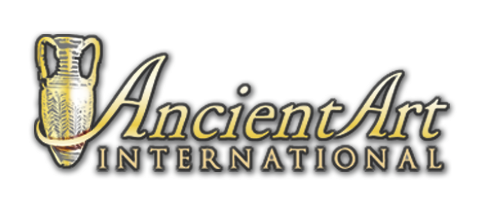Mark and Janeth Sponenburgh Collection
The Mark and Janeth Sponenburgh Gallery’s installation, Across Continents, Trough Time: Selections from the Permanent Collection, features a range of artworks from the Hallie Ford Museum of Art’s permanent collections of European, Asian, and American art. Te collections span 4,500 years of Western and Eastern art history and encompass four continents: Europe, Asia, Africa, and North America. Te collections have been assembled over the years to support the liberal arts curriculum
of Willamette University and to introduce Hallie Ford Museum of Art visitors to some of the major themes and styles in the history of Western and Eastern art. Far from comprehensive or complete, the collections are instead made up of small, unassuming art treasures that are meant to be studied, savored, appreciated, and enjoyed. Te frst university art museum in the United States was founded at Yale University in 1832 by the Revolutionary War hero and American history painter John Trumbull. By the end of the nineteenth century, a number of colleges and universities had established art museums on their campuses, including Vassar College in 1864, Princeton University in 1882, Bowdoin College in 1894, and Harvard University in 1896, among others. From the very beginning, these institutions were founded
to help support the liberal arts curriculums of their respective universities, to provide a vehicle for introducing their students to the history of art, and, in the words of Edward W. Forbes of Harvard University, to build collections that “tell the story of the artistic and imaginative possibilities of man . . .” and to create a place wherein “the student is fred . . . by the inspiration that comes from contact with (original) works of art.”
Among the earliest donors of European art to Willamette University were Methodist Bishop G. Bromley Oxnam and his wife. Bishop Oxnam, who served as President of DePauw University in Greencastle, Indiana, from 1928 to 1936, was a mentor to G. Herbert Smith, who served as dean of freshmen at DePauw and went on to become president of Willamette from 1942 to 1969. During his lifetime, Oxnam and his wife traveled extensively in Europe and Asia and amassed a sizable collection of European and Asian art. When they began to disperse their art collection in the 1950s, they donated fve nineteenth-century French Barbizon paintings to Willamette in honor of Oxnam’s former colleague and protégé. A turning point came in 1990 when Mark and Janeth Sponenburgh donated their art collection to Willamette. Professor Sponenburgh was a sculptor and art historian who, with his wife Janeth Hogue Across Continents, Trough Time Selections from the permanent collection
Sponenburgh, traveled throughout Europe, the Middle East, Central Asia, and the Far East, and amassed an encyclopedic study collection of Western and Eastern art. Although Professor Sponenburgh taught at the University of Oregon and Oregon State University for many years, he and Janeth believed that their art collection, thoughtfully developed over four decades and used as a teaching tool in his art and art history classes, could serve a similar pedagogical role at Willamette. Indeed, their gift in 1990 provided the basis for the creation of the Hallie Ford Museum of Art in 1998. A number of the antiquities on view in the Mark and Janeth Sponenburgh Gallery were given by Richard Brockway, a Willamette alumnus and retired General Telephone and Electronics Corporation (GTE) executive who, since the early 1960s, has amassed a major collection of ancient art, including superb examples of pottery, sculpture, glass, mosaics, coins, and lamps. A. Dean McKenzie, a professor emeritus from the University of Oregon, donated several exquisite examples of ancient and medieval art to the collection, and many of the Asian objects on view were donated by James and Aneta McIntyre. Mr. McIntyre was a geologist who worked in North Africa and the Far East in the late 1950s and early 1960s and who developed a passion for ancient and Asian art, especially Chinese and Japanese art. Still other donors include Muriel Stieber of Salem, who donated a number of pieces of South Italian and Etruscan pottery acquired by her mother in Italy in the 1950s; Marge Riley of Portland, who donated several Greek and Russian Orthodox icons to the collection; Bill and Beverly Galen of Portland, who donated the superb Siennese corpus on view; Willamette alumnus Dan Schneider of Chicago, who donated the John Rogers sculpture and Larry Poons painting; and Michel and Victoria Hersen of Portland, who have a splendid collection of nineteenth-century American landscape paintings and have donated several American works on paper in the past. When the Willamette University alumnus and Harvard Art Museums director James Cuno spoke at the dedication of the Hallie Ford Museum of Art in the fall of 1998, he stated that as we enter the twenty-frst century, we must not lose sight of the power of art museums, and of the works of art that comprise their permanent collections, to instruct, educate, inspire, and delight. Collections, he argued, must remain the heart and soul of any great art museum.
In the spirit of Jim’s eloquent and impassioned words, we encourage you to savor the art treasures that comprise the Hallie Ford Museum of Art’s permanent collections of European, Asian, and American art, and invite you to come back often to visit and enjoy.
John Olbrantz
The Maribeth Collins Director
Hallie Ford Museum of Art
1. Edward W. Forbes, “Te Relationship of the Art Museum to a University,” in Proceedings of the American Association of
Museums, 5 (1911): 55.
2. James Cuno, “To Delight and Instruct: Art Museums at the Turn of the Millennium,” unpublished lecture given on October
1, 1998, at Willamette University in Salem, Oregon, as part of the Hogue-Sponenburgh Art Lecture Series.


